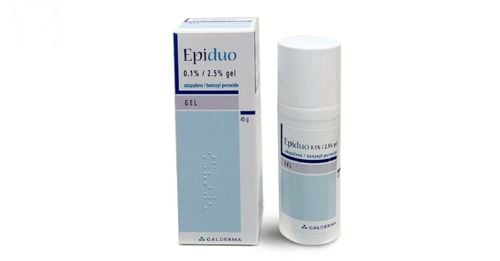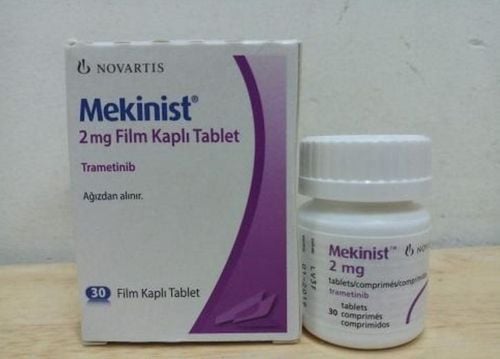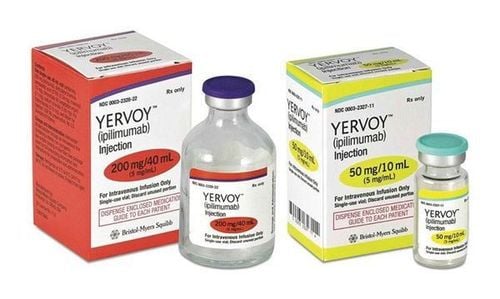This is an automatically translated article.
The skin is the largest organ in the body, and the damage to the skin is also very diverse and caused by many different causes. Although most of the above causes of injury heal on their own, there are also many injuries that become chronic and dangerous.1. Common types of skin lesions
Some common basic skin lesions include:
Macular lesions: These are flat skin lesions on the skin surface that cannot be palpated. The diameter of the maculopapular lesion is less than 10 mm. Macules are pigmented changes that are not raised or recessed above the surface of the skin. Some examples of macular lesions include freckles, flat moles, tattoos, rubella, measles, and some allergic drug rashes. Papules: This lesion is usually raised above the surface of the skin, so it can be felt or palpated. Examples are rice grains, flat lichen, insect bites, acne. Plaque: These are palpable and over 10mm in diameter, raised or concave above the surface of the skin. Plaque lesions can be seen in diseases such as psoriasis... Cubic: This is a papule-like lesion but is dense or the lesion extends into the dermis or dermis. Some examples are cysts, fibroids... Vesicles: are small, fluid-filled lesions inside and are less than 10 mm in diameter. Vesicular lesions are characteristic of diseases such as herpes virus infection, acute contact dermatitis... Blisters are fluid-filled lesions with a diameter of more than 10 mm. Bullous lesions can be formed by burns, allergic and irritant contact dermatitis, drug reactions, and autoimmune bullous skin diseases such as pemphigus. Blisters are often deep lesions that are prone to scarring after the lesion heals. Pustules are lesions that are similar to vesicles but contain pus. Pustular lesions are seen in bacterial infections. Papule: A papule that can appear as a plaque lesion but is caused by dilation of blood vessels under the skin. This is a common manifestation of hypersensitivity reactions such as to drugs, bee or insect stings, autoimmune and usually lasts no more than 24 hours. Scale: is an accumulation of horny cells on the skin, which can be soft or hard. Cases of scabs consisting of serum, blood, or dried pus may be seen in inflammatory or infectious skin disease. Erosion: This damage is caused by partial or complete loss of the epidermis. Erosion can be caused by trauma or can occur in skin infections, lesions caused by scratching. Ulcer: This lesion results from loss of the epidermis and at least part of the dermis. Some examples are pressure ulcers, infection... Hemorrhagic lesions: The bleeding spots are caused by blood escaping from the vessel lumen out of the interstitial space, when pressed the glass does not lose color. Causes include thrombocytopenia, platelet dysfunction, vasculitis, meningococcal disease, etc. Each disease can be described with different types of underlying skin lesions. From the manifestations of lesions on the skin can help identify some of the causes of the disease.
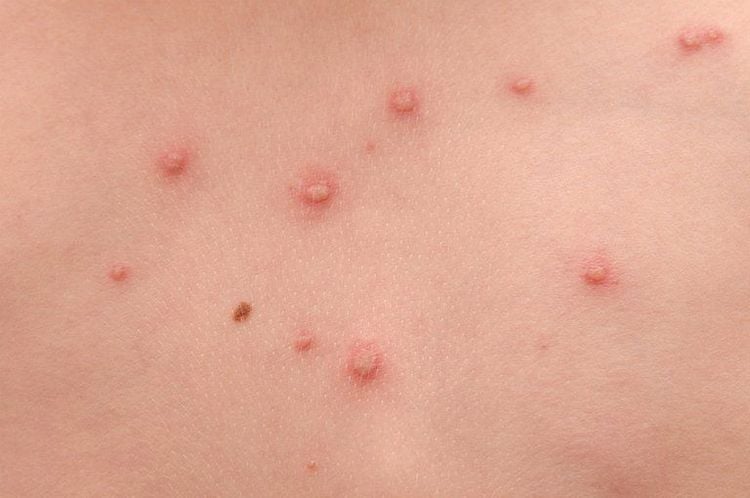
Mụn nước là một tình trạng da bị tổn thương
2. Causes of skin damage
Skin damage can be caused by a variety of causes such as microorganisms, autoimmune diseases, allergic diseases... With each cause of the disease, these lesions on the skin have symptoms. are different and also require different treatment and care measures. Here are some common causes of skin lesions:
Eczema: Also known as atopic dermatitis, it usually begins when you are young. The primary lesion in common eczema is blisters and tends to appear in folds such as the elbows, knees, or wrists, but can affect other places such as the scalp or cheeks. Often accompanied by itching and dryness of the skin. This disease can recur when exposed to pathogens or when the weather is dry. The treatment helps to improve the uncomfortable symptoms of the disease and limit the recurrence of the disease. Acne: When dead skin cells build up and clog pores, acne can appear with red, white, or black breakouts. Some factors that increase your risk include hormones, family history, and use of certain medications. To treat acne you need to clean the skin, keep the acne free of bacteria and use some medications prescribed by your doctor. Autoimmune Factor B Psoriasis: This is an autoimmune disease that can be acquired when your immune system is overactive, causing skin cells to grow faster than normal and causing Let it build up instead of flaking off. Psoriasis lesions are rough, scaly and raised patches called patches on the skin, often found in pressure places such as elbows, knees, etc. Your doctor will treat it with topical therapies, medications you take by mouth or injection, or light therapy. Pemphigus disease: This is a very rare autoimmune disease that causes lesions primarily as blisters, causing the breakdown of skin cells. These blisters are very fragile, soft to the touch, and they need to be treated to avoid the risk of complications such as infection. Tumor-like lesions on the skin Some benign tumors such as lipomas and fibroids cause lumpy lesions on the skin. Skin cancer: If you see open sores that don't heal, red or irritated patches, puffy bumps, small pink spots or scar-like nodules, especially if they're new or growing in any where. They usually appear in places that often see the sun such as the face, neck, scalp, chest, and back. When you see these long-lasting lesions, you should go to medical facilities for early examination.
Herpes Simplex: This is caused by a virus and is basically blisters on the mouth and genitals and can be accompanied by a fever, which can be painful and filled with fluid. It is possible to get the disease through kissing or oral sex. It can go away on its own without even knowing it, or doctors can treat it with oral antivirals and medications to treat symptoms. Eczema: This type of lesion is usually coin-shaped, red, pinkish, or brown, and may water, itch, or burn. It usually appears on the arms, legs, trunk, or hands. Anyone can get it, but men tend to get it more often than women. When infected, it is necessary to treat with corticosteroids and antibiotics. Keratosis pilaris: Years of sun exposure can lead to rough, scaly patches on the face, ears, forearms, scalp, or back of the hands, and these often appear after the age of 40, which is also likely. turn into skin cancer. Doctors can treat these lesions with medication or remove them by freezing or surgically removing them. Impetigo: Red sores near the nose, mouth, and on the hands and feet that develop into brown scabs, impetigo is caused by bacteria and is most common in children and infants. The disease is caused by bacteria, so it needs to be treated with antibiotic cream. Scabies: Small bugs scientifically known as Sarcoptes scabiei can burrow into the skin and cause red, itchy bumps, often in skin folds. You can get the disease by sharing bedding or clothing with someone who has scabies. The disease does not go away on its own and needs to be treated with topical medications or may need to be taken by mouth. Contact dermatitis: Certain substances found in makeup, metals, dyes, soaps, or some poisonous plants can irritate and inflame your skin. Skin lesions that form blisters and itch at the point of contact with the irritant or allergen. Treatment requires topical steroids or, in some cases, oral or injectable medications to care for severe skin lesions.
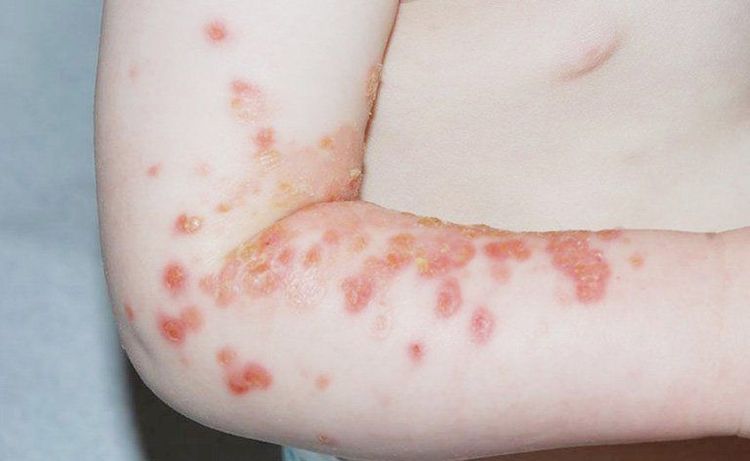
Chốc lở là một trong các nguyên nhân khiến da bị tổn thương
3. Notes on skin damage
Skin lesions are very diverse, so if you see lesions that are not sure what is the cause and you are worried about it, you should see a doctor to know the most appropriate treatment. In addition, if the lesion is found to be long-lasting, accompanied by fever, pain and it affects the quality of life, go to the doctor soon. Do not use unsanitary solutions or leaves on skin lesions, because there is a risk of infection. Avoid indiscriminate use of drugs especially antibiotics and steroid anti-inflammatory drugs. Because some cases are not necessary or increase the risk of complications. Healthy diet: Avoid alcohol, stimulants, increase green vegetables and fruits. Take care of skin lesions to avoid infection by applying gauze to the lesions, try to limit scratching the lesions, wash them with dilute salt water... Hopefully through the article you have learned some of the causes of damage. skin injury. From there, the most appropriate care and treatment methods are available. Some skin lesions need to be treated in order to be cured, so if you see long-lasting lesions, there are signs of infection such as fever, pus discharge, a lot of pain... need to visit and treat soon.
Please dial HOTLINE for more information or register for an appointment HERE. Download MyVinmec app to make appointments faster and to manage your bookings easily.




